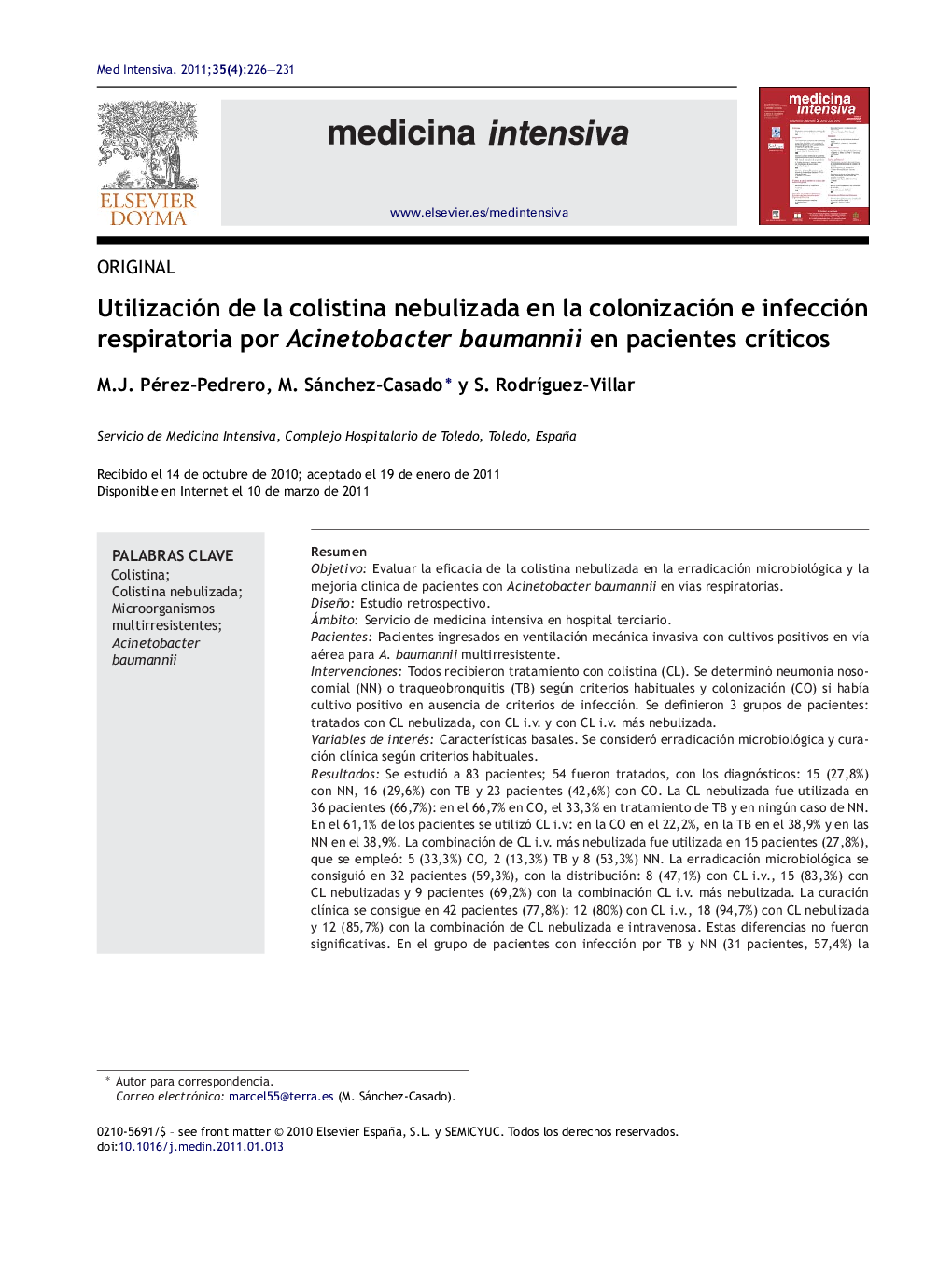| Article ID | Journal | Published Year | Pages | File Type |
|---|---|---|---|---|
| 3113328 | Medicina Intensiva | 2011 | 6 Pages |
ResumenObjetivoEvaluar la eficacia de la colistina nebulizada en la erradicación microbiológica y la mejoría clínica de pacientes con Acinetobacter baumannii en vías respiratorias.DiseñoEstudio retrospectivo.ÁmbitoServicio de medicina intensiva en hospital terciario.PacientesPacientes ingresados en ventilación mecánica invasiva con cultivos positivos en vía aérea para A. baumannii multirresistente.IntervencionesTodos recibieron tratamiento con colistina (CL). Se determinó neumonía nosocomial (NN) o traqueobronquitis (TB) según criterios habituales y colonización (CO) si había cultivo positivo en ausencia de criterios de infección. Se definieron 3 grupos de pacientes: tratados con CL nebulizada, con CL i.v. y con CL i.v. más nebulizada.Variables de interésCaracterísticas basales. Se consideró erradicación microbiológica y curación clínica según criterios habituales.ResultadosSe estudió a 83 pacientes; 54 fueron tratados, con los diagnósticos: 15 (27,8%) con NN, 16 (29,6%) con TB y 23 pacientes (42,6%) con CO. La CL nebulizada fue utilizada en 36 pacientes (66,7%): en el 66,7% en CO, el 33,3% en tratamiento de TB y en ningún caso de NN. En el 61,1% de los pacientes se utilizó CL i.v: en la CO en el 22,2%, en la TB en el 38,9% y en las NN en el 38,9%. La combinación de CL i.v. más nebulizada fue utilizada en 15 pacientes (27,8%), que se empleó: 5 (33,3%) CO, 2 (13,3%) TB y 8 (53,3%) NN. La erradicación microbiológica se consiguió en 32 pacientes (59,3%), con la distribución: 8 (47,1%) con CL i.v., 15 (83,3%) con CL nebulizadas y 9 pacientes (69,2%) con la combinación CL i.v. más nebulizada. La curación clínica se consigue en 42 pacientes (77,8%): 12 (80%) con CL i.v., 18 (94,7%) con CL nebulizada y 12 (85,7%) con la combinación de CL nebulizada e intravenosa. Estas diferencias no fueron significativas. En el grupo de pacientes con infección por TB y NN (31 pacientes, 57,4%) la erradicación microbiológica se consiguió en 5 pacientes (100%) tratados con CL nebulizada y en 6 de 14 (42,9%) tratados con CL i.v.; esta diferencia fue significativa (p < 0,05). La curación clínica en este grupo fue del 100% (6 pacientes) tratados con CL nebulizada y del 75% (9 de 12) en el grupo de CL i.v. Esta diferencia no fue significativa.ConclusionesNuestro estudio señala que el tratamiento con colistina en pacientes con infección pulmonar por A. baumannii multinrresistente podría ser más eficaz si se administra nebulizada o en combinación con colistina i.v. que si se administra de forma intravenosa solamente.
ObjectiveTo analyze the efficacy of nebulized colistin in the microbiological eradication and clinical improvement of patients with pulmonary infection by multi-resistant Acinetobacter baumannii (MAB).DesignA retrospective study.SettingIntensive Care Unit of a Tertiary hospital.PatientsHospitalized patients on invasive mechanical ventilation with positive MAB cultures of the airway.InterventionsAll received treatment with colistin (CL). Nosocomial pneumonia (NP) or Tracheobronchitis (TB) was determined according to routine criteria and colonization (CO) was determined in the case of a positive culture in the absence of infection criteria. Three groups of patients were defined: those treated with nebulized CL, those treated with IV CL and those treated with IV CL plus nebulized CL.Main measurementsBaseline characteristics. Microbiological eradication and clinical recovery were evaluated according to routine criteria.Results83 patients were studied, 54 of whom were treated, with the following diagnoses: 15 (27.8%) with NP, 16 (29.6%) with TB and 23 patients (42.6%) with CO. Nebulized CL was used in 36 patients (66.7%): 66.7% of which for CO, 33.3% in treatment for TB and in no case of NP. In 61.1% of the patients, IV CL was used: 22.2% of which for CO, 38.9% for TB and 38.9% in NP. The combination of IV CL and nebulized CL was used in 15 patients (27.8%): 5 patients (33.3%) CO, 2 patients (13.3%) TB and 8 patients (53.3%) NP. Microbiological eradication was achieved in 32 patients (59.3%), with the following distribution: 8 (47.1%) with IV CL, 15 (83.3%) with nebulized CL and 9 patients (69.2%) with a combination of IV CL and nebulized CL. Clinical recovery was achieved in 42 patients (77.8%): 12 (80%) with IV CL, 18 (94.7%) with nebulized CL and 12 (85.7%) with a combination of nebulized and IV CL. These differences were not significant. In the group of patients with infection due to TB and NP (31 patients, 57.4%), microbiological eradication was achieved in 5 patients (100%) treated with nebulized CL and in 6 of the 9 patients (42.9%) treated with IV CL, the difference being significant (P < .05). Clinical recovery in this group was 100% (6 patients) treated with nebulized CL and 75% (9 of the 12 patients) in the IV CL group. This difference was not significant.ConclusionsOur study suggests that treatment with colistin in patients with pulmonary infection with multi-resistant Acinetobacter baumannii could be more efficient if it were to be administrated solely nebulized or in combination with IV colistin rather than administered solely intravenously.
